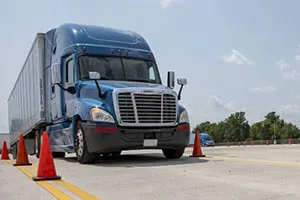Staff Reporter
Driver Recruitment Success Hinges on Freight Turnaround

[Stay on top of transportation news: Get TTNews in your inbox.]
Experts are having a difficult time predicting the demand for professional truck drivers this year, saying it ultimately will hinge on an anticipated freight market turnaround.
Freight movement saw a significant slowdown in 2023 coming off more than two years of pandemic-driven demand. This has led to driver recruitment and retention being less of a focus. But how the new year plays out will depend on what the market does.
“I think everybody is taking a wait-and-see approach,” said Scott Dismuke, vice president of operations at employee retention and analytics firm Professional Driver Agency. “If you go back to the first of this year, I think folks were predicting that things may turn around in the third quarter of this year. Well, obviously, it didn’t.”
Dismuke also noted the seasonal holiday bump this year wasn’t as significant as many were hoping for. He saw that trend continue into the year with the predicted turnaround being pushed back to the first or second quarter of 2024. Even more recently, that has again shifted to the back end of the year.

Dismuke
“I think ultimately, nobody really knows,” Dismuke said. “You’re also going into an election year, which I think adds to some of the uncertainty that we normally face in an election year, particularly when you look at how divided the country is politically. So, I think there’s uncertainty with the election. Obviously, there’s uncertainty overseas.”
The Fall 2023 Driver Survey, released by PDA and Conversion Interactive Agency, found 56.1% of truck drivers were optimistic about the impending end of the freight recession. The survey also revealed that only 33.3% of drivers are currently searching for another job. Of those, 62.8% indicated they wanted more predictable pay.
“I think that the most important thing for fleets to think about going into the new year would be, ‘Do I understand the data around all of my recruiting,’ ” said Priscilla Peters, vice president of marketing at Conversion. “Knowing and understanding what your value proposition is for drivers who come to drive for you, having a good strategic marketing plan in place, those are always going to be fundamental.”

Peters
Peters also noted that carriers should understand how drivers are being paid in the regions they recruit, where their best performing sources are for driver leads and what driver personas they want to attract in individual markets.
She also believes technology is becoming even more important when it comes to driver recruitment.
“I think those who are actually telling their brand stories online, in a much more compelling way to stand out in the market, they’re going to win,” Peters said. “The technology side of that is new but telling your brand story, that’s not.
“We’ve had conversations about that for years. I just think that it’s a mix of, yes, we have to stay foundationally with what we know to be successful in recruiting, but also we have to know and understand the technology of today.”
Dismuke pointed out that freight recessions historically have lasted 18 to 22 months. He noted the freight industry is in that range based on when the post-pandemic slowdown began, but he has yet to see signs indicating a recovery.
“I think that when this does bounce back, we’re going to see a lot of turn,” Dismuke said. “You’re going to see a lot of companies start talking about how much freight they have and what the pay is going to be. You can make more money, come work for us.
ERoad's Craig Marris gives advice on carving out a practical, effective road map to a greener and more efficient fleet. Tune in above or by going to RoadSigns.ttnews.com.
“One of the things, again, that we saw in our driver survey is the 66% of drivers that told us that they were not looking for a job, I believe just looking at the data, is a really soft 66%.”
The Fall 2023 Driver Survey found that among drivers not looking for a new job, 13.9% were afraid to make a move in the current economy. Some 15.6% of respondents said they just need more experience, but 60.1% reported being happy where they were.
“If you take those two numbers combined, you’re looking at 30% to 35% of these drivers that within six months, if things change, very well could be looking for a job,” Dismuke said. “I think that as the industry comes out of this freight recession, whenever that is, we’re looking at a very interesting situation from a recruiting and retention standpoint. I would argue that it could be worse after this than it was before.”
XPO reported a record for full-time driver hires in the fourth quarter amid a loosening labor market impacting the availability of drivers. But the less-than-truckload carrier also has found that recruiting in some geographical areas remains challenging. Company leadership also has reassessed how sign-on and retention bonuses are utilized, with incentives now being mainly focused on critical and hard-to-fill roles.
“Given ongoing market uncertainties, I expect companies will prioritize agility in recruiting while also adopting a more thoughtful approach to attrition,” said Carolyn Roach, chief human resources officers at XPO. “For example, I expect to see a bigger emphasis on companies optimizing their headcount before backfilling in kind.”
I think you’ll see companies continue to look inward at their own talent.
Carolyn Roach, XPO chief human resources officer
Roach also foresees a notable shift in the skills companies are hiring for. She noted that they will anticipate organizational needs for the next two to three years rather than hiring for the skills they need now. She sees learning agility, attitude and energy as being key qualities that will help drivers rise to the top of the talent pool. XPO ranks No. 5 on the Transport Topics Top 100 list of the largest for-hire carriers in North America.
“I think you’ll see companies continue to look inward at their own talent,” Roach said. “The companies that will be most successful will utilize strong leadership and development programs to empower and upskill their employees.
“While this is important to all generations in the workforce, it’s especially key to attracting and retaining the most recent entrants into the labor force who not only seek but inherently expect such investments in their professional growth.”

“There still is going to be a significant amount of drivers needed,” says MG Truck Driving School Director of Education Rusell Hoyt. (MG Truck Driving School)
The MG Truck Driving School in Glendale, Ariz., reported that 98% of its graduates have found jobs since it opened Sept. 5. It continues to see interest from people wanting to be drivers and carriers wanting to hire them despite the freight market downturn.
“There still is going to be a significant amount of drivers needed,” MG Director of Education Russell Hoyt said. “Thousands upon thousands of drivers are needed right now. That isn’t going to change come January. They’re still going to be needed, and then that loss of drivers beginning to retire is going to start taking its toll.”
Hoyt believes this shows becoming a driver still is viable, even when the market is down. But he notes that how strong the demand for drivers will be depends on the freight market turnaround and how the presidential election plays out. Those considerations, he says, ultimately will dictate how many drivers are needed and how quickly.
“There’s a larger picture at play that most people don’t talk about,” Hoyt said. “The larger picture is within the next 12 months, definitely within the next 18 months, we’re going to have an entire generation of drivers starting to retire out.
“And if you factor in the boomers that stayed in when they were going to retire and the next group after them, there’s a potential of needing several hundred thousand drivers, and that’s a scary thing. It could collapse our industry.”
Want more news? Listen to today's daily briefing below or go here for more info:





